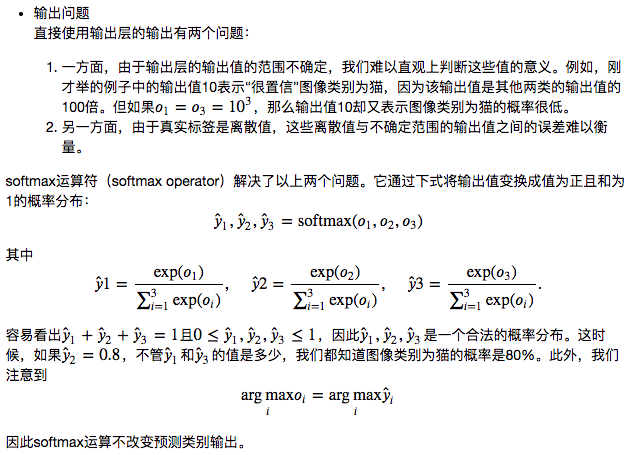课程引用自伯禹平台:https://www.boyuai.com/elites/course/cZu18YmweLv10OeV
《动手学深度学习》官方网址:http://zh.gluon.ai/ ——面向中文读者的能运行、可讨论的深度学习教科书。
Task 1: 线性回归、Softmax与分类
课程详细内容在https://www.boyuai.com/elites/course/cZu18YmweLv10OeV/jupyter/FUT2TsxGNn4g4JY1ayb1W
(Task2 RNN模型: https://www.cnblogs.com/haiyanli/p/12309289.html)
这里记录个别内容;
#以前未注意矢量计算
1. 矢量计算
在模型训练或预测时,我们常常会同时处理多个数据样本并用到矢量计算。在介绍线性回归的矢量计算表达式之前,让我们先考虑对两个向量相加的两种方法。
- 向量相加的一种方法是,将这两个向量按元素逐一做标量加法。
- 向量相加的另一种方法是,将这两个向量直接做矢量加法。
代码示例:import torch
import time
# init variable a, b as 1000 dimension vector
n = 1000
a = torch.ones(n)
b = torch.ones(n)
# define a timer class to record time
class Timer(object):
"""Record multiple running times."""
def __init__(self):
self.times = []
self.start()
def start(self):
# start the timer
self.start_time = time.time()
def stop(self):
# stop the timer and record time into a list
self.times.append(time.time() - self.start_time)
return self.times[-1]
def avg(self):
# calculate the average and return
return sum(self.times)/len(self.times)
def sum(self):
# return the sum of recorded time
return sum(self.times)
timer = Timer()
c = torch.zeros(n)
for i in range(n):
c[i] = a[i] + b[i]
'%.5f sec' % timer.stop()
timer.start()
d = a + b
'%.5f sec' % timer.stop()
运行后结果很明显,后者比前者运算速度更快。因此,我们应该尽可能采用矢量计算,以提升计算效率。
2、借鉴平台的Pytorch代码学习,多看,多练
import torch
from torch import nn
import numpy as np
torch.manual_seed(1)
#generate data
num_inputs = 2
num_examples = 1000
true_w = [2, -3.4]
true_b = 4.2
features = torch.tensor(np.random.normal(0, 1, (num_examples, num_inputs)), dtype=torch.float)
labels = true_w[0] * features[:, 0] + true_w[1] * features[:, 1] + true_b
labels += torch.tensor(np.random.normal(0, 0.01, size=labels.size()), dtype=torch.float)
#load data
import torch.utils.data as Data
batch_size = 10
# combine featues and labels of dataset
dataset = Data.TensorDataset(features, labels)
# put dataset into DataLoader
data_iter = Data.DataLoader(
dataset=dataset, # torch TensorDataset format
batch_size=batch_size, # mini batch size
shuffle=True, # whether shuffle the data or not
num_workers=0, # read data in multithreading
)
#define module
class LinearNet(nn.Module):
def __init__(self, n_feature):
super(LinearNet, self).__init__() # call father function to init
self.linear = nn.Linear(n_feature, 1) # function prototype: `torch.nn.Linear(in_features, out_features, bias=True)`
def forward(self, x):
y = self.linear(x)
return y
#load net
net = LinearNet(num_inputs)
print(net)
#define loss
loss = nn.MSELoss()
#define optimizer
import torch.optim as optim
optimizer = optim.SGD(net.parameters(), lr=0.03) # built-in random gradient descent function
#train
num_epochs = 3
for epoch in range(1, num_epochs + 1):
for X, y in data_iter:
output = net(X)
l = loss(output, y.view(-1, 1))
optimizer.zero_grad() # reset gradient, equal to net.zero_grad()
l.backward()
optimizer.step()
print('epoch %d, loss: %f' % (epoch, l.item()))
#view para
for param in net.parameters():
print(param)
3、Softmax解决的神经网络输出带来的问题(来自课程内容)
